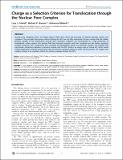| dc.contributor.author | Colwell, Lucy J. | |
| dc.contributor.author | Brenner, Michael P. | |
| dc.contributor.author | Ribbeck, Katharina | |
| dc.date.accessioned | 2011-10-17T19:40:55Z | |
| dc.date.available | 2011-10-17T19:40:55Z | |
| dc.date.issued | 2010-04 | |
| dc.date.submitted | 2009-09 | |
| dc.identifier.issn | 1553-7358 | |
| dc.identifier.issn | 1553-734X | |
| dc.identifier.uri | http://hdl.handle.net/1721.1/66306 | |
| dc.description.abstract | Nuclear pore complexes (NPCs) are highly selective filters that control the exchange of material between nucleus and cytoplasm. The principles that govern selective filtering by NPCs are not fully understood. Previous studies find that cellular proteins capable of fast translocation through NPCs (transport receptors) are characterized by a high proportion of hydrophobic surface regions. Our analysis finds that transport receptors and their complexes are also highly negatively charged. Moreover, NPC components that constitute the permeability barrier are positively charged. We estimate that electrostatic interactions between a transport receptor and the NPC result in an energy gain of several kBT, which would enable significantly increased translocation rates of transport receptors relative to other cellular proteins. We suggest that negative charge is an essential criterion for selective passage through the NPC. | en_US |
| dc.description.sponsorship | Merck Research Laboratories | en_US |
| dc.description.sponsorship | National Science Foundation (U.S.) (Division of Mathematical Sciences) | en_US |
| dc.description.sponsorship | Kavli Institute for Bionano Science & Technology at Harvard University | en_US |
| dc.description.sponsorship | National Centers for Systems Biology (U.S.) (NIGMS grant GM068763) | en_US |
| dc.description.sponsorship | National Institute of General Medical Sciences (U.S.) | en_US |
| dc.language.iso | en_US | |
| dc.publisher | Public Library of Science | en_US |
| dc.relation.isversionof | http://dx.doi.org/10.1371/journal.pcbi.1000747 | en_US |
| dc.rights | Creative Commons Attribution | en_US |
| dc.rights.uri | http://creativecommons.org/licenses/by/2.5/ | en_US |
| dc.source | PLoS | en_US |
| dc.title | Charge as a Selection Criterion for Translocation through the Nuclear Pore Complex | en_US |
| dc.type | Article | en_US |
| dc.identifier.citation | Colwell, Lucy J., Brenner, Michael P., Ribbeck, Katharina. "Charge as a Selection Criterion for Translocation through the Nuclear Pore Complex." PLoS Comput Biol (2010) 6(4): e1000747. | en_US |
| dc.contributor.department | Massachusetts Institute of Technology. Department of Biological Engineering | en_US |
| dc.contributor.approver | Ribbeck, Katharina | |
| dc.contributor.mitauthor | Ribbeck, Katharina | |
| dc.relation.journal | PloS Computational Biology | en_US |
| dc.eprint.version | Final published version | en_US |
| dc.type.uri | http://purl.org/eprint/type/JournalArticle | en_US |
| eprint.status | http://purl.org/eprint/status/PeerReviewed | en_US |
| dspace.orderedauthors | Colwell, Lucy J.; Brenner, Michael P.; Ribbeck, Katharina | en |
| dc.identifier.orcid | https://orcid.org/0000-0001-8260-338X | |
| mit.license | PUBLISHER_CC | en_US |
| mit.metadata.status | Complete | |
